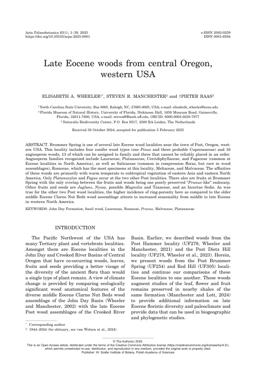2025-06-01
Late Eocene woods from central Oregon, western USA
Publication
Publication
Acta Palaeobotanica , Volume 65 - Issue 1 p. 1- 39
Brummer Spring is one of several late Eocene wood localities near the town of Post, Oregon, western USA. This locality includes four conifer wood types (one Pinus and three probable Cupressaceae) and 16 angiosperm woods, 13 of which can be assigned to family and three that cannot be reliably placed in an order. Angiosperm families recognized include Lauraceae, Platanaceae, Cercidiphyllaceae, and Fagaceae (common at Eocene localities in North America), as well as Salicaceae (common in compression floras, but rare in wood assemblages), Rosaceae, which has the most specimens at this locality, Meliaceae, and Malvaceae. The affinities of these woods are primarily with warm temperate to subtropical vegetation of eastern Asia and eastern North America. Only Platanoxylon and Fagus occur at the two other Post localities. There also are fruits at Brummer Spring with the only overlap between the fruits and woods being one poorly preserved “Prunus-like” endocarp. Other fruits and seeds are Juglans, Nyssa, possible Magnolia and Taxaceae, and an Incertae Sedis. As was true for the other two Post wood localities, the higher incidence of ring-porosity here as compared to the older middle Eocene Clarno Nut Beds wood assemblage attests to increased seasonality from middle to late Eocene in western North America.
| Additional Metadata | |
|---|---|
| , , , , , , | |
| doi.org/10.35535/acpa-2025-0001 | |
| Acta Palaeobotanica | |
| Released under the CC-BY 4.0 (“Attribution 4.0 International”) License | |
| Organisation | Staff publications |
|
Wheeler, Elisabeth, Manchester, Steven R., & Baas, P. (2025). Late Eocene woods from central Oregon, western USA. Acta Palaeobotanica, 65(1), 1–39. doi:10.35535/acpa-2025-0001 |
|
